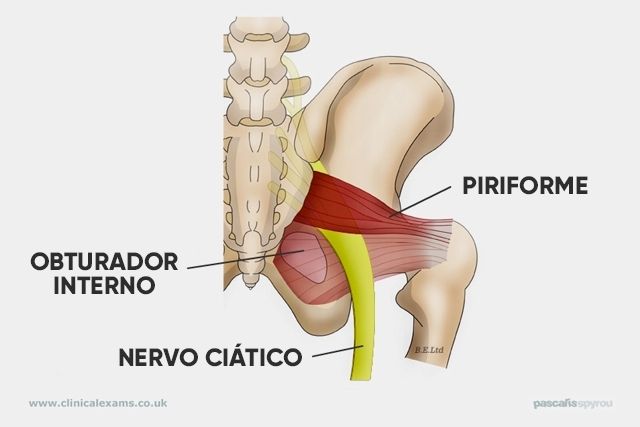
By the healthiergang writer , student in Medicine and Surgery.
Piriformis muscle
The Piriformis is a small muscle, thin and almost triangular in shape, which originates at the level of the sacral portion of the vertebral column; more precisely from the anterior portion of the sacral foramina between S2 and S4; moving downwards and externally it is inserted, forming a single tendon, at the level of the upper portion of the greater trochanter of the Femur.
As it crosses the pelvis, it passes into the ischial foramen and relates in various ways to the Ischial Nerve (or Sciatico): in fact in some cases it may be located above the nerve or it is the Sciatic itself that crosses its muscular belly.
It is a deep muscle, covered by the mass of the gluteus maximus and in part by that of the gluteus medius, in fact it is not possible to reach it and palpate it directly. When the pelvis is in a neutral position as an extrarotator of the femur (acting on the coxo-femoral joint), it is considered a hip abductor and when it pivots on the femur it contributes to the retroversion of the pelvis; furthermore, always with the pelvis in a neutral position (so let's imagine the subject standing upright) it acts as a stabilizer.
During the movement, when there is the support phase of the lower limb, the ipsilateral piriformis contracting opposes the abrupt femoral internal rotation (very useful in the support phase during running and walking).
Inflammation
If an inflammatory or fatigue process involves this small muscle then we are talking about Piriformis Syndrome which is a nerve crushing syndrome. The cause of the symptoms is to be found in the close relationship between the muscle and the sciatic nerve.
It generally occurs as a pain that involves the entire nerve tract and is often mistaken for a herniated disc or lumbosciatalgia.
In fact, it has been seen that as a syndrome it is very little considered by specialists and almost all patients suffering from chronic sciatic pain have never heard of it; yet it is estimated that about 40% of the aforementioned patients have problems attributable to this muscle, the most common cause of muscle inflammation is an incorrect sitting position or excessive time spent in the chair.
In fact, the muscle is always crushed and compressed, which then leads to its stiffening and inflammation. Other reasons can be found in postural imbalances and in the misalignment of the pelvis that lead a muscle to work more than its counterpart causing thickening of the muscle and crushing of the sciatic nerve or in trauma involving the lower back or the gluteal region.
The most common symptom is pain and discomfort in the center of the buttock, pain that can radiate down the back of the thigh up to the knee; if the crushing is important then you can have a tingling and a feeling of numbness up to the leg and foot, therefore a symptomatology that involves the whole sciatic.
Sitting and performing thigh rotations against resistance cause severe pain as well as performing certain activities such as walking, climbing stairs, which generally lead to worsening of symptoms. With the presence of this symptomatological picture, tests can be used to help us identify the syndrome and make a correct differential diagnosis.
How to behave?
We then begin with the anamnesis (ie the list of symptoms reported by the patient) and with a physical examination of the hip and lumbar area; from here the specialist can carry out various tests:
- Palpation of the gluteal region in the center of the muscle belly, where the nerve and muscle usually pass underneath and which are the most painful points.
- The Freiberg test which is performed with the patient lying prone on the couch and consists in the internal rotation of the hip bringing the knee outwards.
- The Pace and Nagle test: the patient is sitting with his legs hanging off the table; abduction and isometric external rotation of the hips is performed against resistance; these movements cause pain and in the worst symptoms they cannot even be carried out
- Faber test: it is performed by bringing the hip joint into flexion, abduction and extrarotation (hence the name of the F. AB. ER. Test), causing pain in the hip.
To differentiate it from a radical involvement, the Lasegue test is also performed, which does not cause pain in the case of inflammation of the piriformis and therefore useful in the identification phase of the cause.
Physical therapies are those that give the best results without the use and contraindications of drugs, such as Tecar therapy and Ultrasound with massage. The direct massage alone can be useful but not always effective since the muscle is located in depth.
Stretching, on the other hand, is a good ally and you can do it all in the comfort of your own home
We start in the supine position; we bring the left ankle in contact with the right knee and with the hands we grab the same knee bringing it to the chest; the part being stretched will be at the level of the left buttock; maintain the position for 20-30 seconds, performing the exercise for both limbs at least 3 times; the muscle will be stretched leading to a feeling of relief and a decrease in stiffness.
In the assumed position you can also perform a massage with a foam roller or a tennis ball as an alternative.


























